The modern market for insulation materials is quite dynamic. Requirements for thermal insulation of premises are changing, SNiPs are being revised, customer requirements for energy-saving parameters of construction projects are being tightened. In response, the range of materials is expanding, and popular models are improving their qualities.
Reflective insulation has become one of the innovations in the field of insulation. The material is produced in rolls and has universal properties that simultaneously combine the functions of heat, steam, hydro and sound insulation.
The structure and principle of action of penofol
Foil-clad penofol is a multilayer material from the class of reflective insulation. The main functions of penofol are to protect structures from drafts and wind, moisture and condensation, vapors rising up from the lower tiers of the structure, as well as from external sounds and noises. Penofol is a versatile insulating material, since it has the qualities of sound, steam, hydro and thermal insulation. These properties are due to the structure of the material and the technology of its production.
The basis of the heat insulator is closed cell polyethylene foam, which is filled with air. Polyethylene foam is used in various thicknesses, densities and structures. On one or two sides (depending on the purpose of the foam), polyethylene is covered with aluminum foil. The foil is pre-processed - polished to the maximum reflectance (97% or more). Aluminum foil is applied by heat welding, which ensures reliable adhesion of materials.
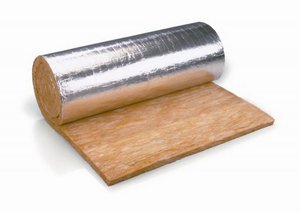
The thickness of the base is 2-10 mm, the thickness of the foil is about 12-30 microns. The total thickness of penofol can reach 40 mm - the use of such an "insulator" is relevant only for regions with harsh climatic conditions.
The principle of operation of penofol is based on the work of the "Dewar vessel". James Dewar, at the beginning of the twentieth century, found out that any substance has a certain resistance to heat transfer. Regardless of the value of this indicator, the material can only slow down the heat transfer process, but not stop it completely. At the same time, the substance accumulates heat waves, thereby accumulating energy in itself. After a while, oversaturation occurs and the material begins to generate heat.
In the course of experiments, James Dewar identified a number of substances that tend not to absorb heat energy, but to reflect it. These materials include: precious metals (gold, platinum, silver) and pure, polished aluminum. Heat rays, reaching the metal surface, are reflected by almost 99%. But, "reflectors" are good heat conductors, so they must be used in tandem with materials capable of absorbing heat.
A common thermos has a similar principle of operation, and the scientist's research was the basis for the creation of spacesuits for astronauts and thermal insulation materials reflective type.
The use of one- and two-sided reflective insulators reduces the cost of heating the premises in winter, and in summer, in hot weather, slows down the heating of the house.
Advantages and disadvantages of thermal insulation material
The advantages of penofol include the following qualities:

With all the variety and undeniable advantages, some disadvantages are inherent in the insulation:
- Excessive softness limits the scope of penofol. It is not suitable for wall insulation under plaster or wallpaper.
- For fixing penofol, you may need special glue. Self-adhesive penofol is devoid of this minus.
- Despite the good characteristics, experts do not recommend using penofol as an independent insulation for external walls of buildings. It attaches like additional layer to reflect heat energy and protect the structure from moisture.
Penofol: technical characteristics
Penofol has the following characteristics:

- operating temperature range from -60 ° С to + 100 ° С;
- thermal reflection coefficient of the surface 95-97%;
- the thermal conductivity coefficient depends on the operating conditions and fluctuates in the range of 0.037-0.052 W / m ° С;
- water absorption by volume - 0.35-0.7% - this indicator indicates reliable protection frame elements and floors from moisture penetration;
- with a material thickness of 4 mm specific gravity is 44-74 kg / m3 (the value depends on the type of penofol);
- vapor permeability is not more than 0.001 mg / m h Pa - this value allows us to call penofol a good barrier to fumes;
- ultimate strength during compression 0.035 MPa;
- specific heat capacity 1.95 J / kg ° С;
- sound absorption - not less than 32 dB.
Scope of penofol
For warming summer country houses and thermal insulation of high-rise buildings, universal penofol is suitable. The characteristics of the material have led to its wide popularity and demand, both in the construction of fundamental buildings, and in the execution renovation works houses.
Penofol is used for the following purposes:
- Thermal insulation:
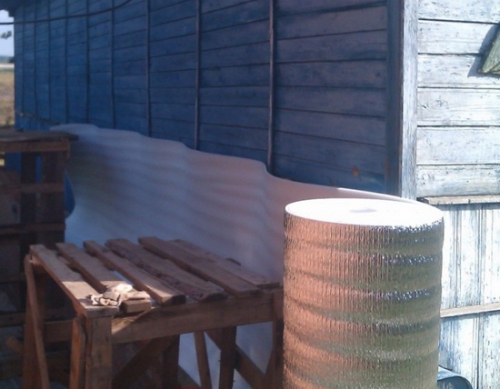
- Processing of structure elements:

Important! Reflective penofol will not only help to preserve the warmth in the house in winter as much as possible. Laid under the roof, it will not allow the scorching summer heat to enter the room
Types of foil-clad penofol
Manufacturers offer several types of penofol for different purposes. In the traditional classification, there are three classes of material:
- Type A- one-sided penofol (a layer of aluminum film is applied on one side of the foamed polyethylene). This type is used mainly as an addition to the main thermal insulation - foam or styrodor.
- Type B- double-sided foil penofol, universal and can be used as stand-alone insulation.
- Type C - self-adhesive type of insulation. On the one hand - a reflective layer of aluminum, and on the other - polyethylene foam with moisture-resistant glue, protected by a sticker. Self-adhesive penofol is convenient for finishing inconvenient sections of the structure, so additional installation tools are not required for work.

In addition to the standard types of penofol, technologists have developed a number of modifications that have taken their niche in the construction market:
- aLP type - laminated penofol, one of the foil sides of the insulation is covered with plastic wrap; Penofol class ALP is used for insulation of agricultural buildings, which are operated in a mildly aggressive environment;
- types Mand R- insulation with one-sided foil, has a relief surface;
- penofol AIRintended for the arrangement of air exhaust structures;
- penofol Super NET(translated from English "network") - the main task is heat and vapor insulation of pipelines, air outlets and heating mains.
Choosing the optimal type of penofol
The main parameters that should be considered when choosing penofol:
- type of insulation (one- or two-sided);
- manufacturer (it should be noted that "Penofol" is the name of the brand, and not the type of insulation; others construction companies make it under other commercial names);
- price category;
- material thickness.

- The cost of penofol is primarily influenced by its thickness and the number of aluminum layers. Standard sizes material: 3,4,5,8 and 10 mm. One-sided penofol in sizes 3 and 4 mm of type A can be purchased for 50 rubles / m2. Penofol 10 mm type B is considered the most durable and expensive, its price ranges from 100-130 rubles / m2.
- The assortment of building stores has the Penofol 2000 marking - a cheaper analogue of standard penofol (you can buy the material at a price of 35 rubles / m2). However, experts note that Penofol 2000 is inferior in strength to branded insulation.
- The optimal ratio of cost and performance is demonstrated by 5 millimeter penofol (the price of such a heater is about 70 rubles / m2).
- Penofol type A is suitable for insulating roofs, basements, saunas, balconies, ceilings and walls; for arranging wood floors it is better to use class B, and for insulation of the car interior and metal structures - penofol type C.
Video: comparative characteristics of penofol and its analogues
Features of styling penofol
The maximum effect of insulation with penofol will be achieved if certain rules are observed:
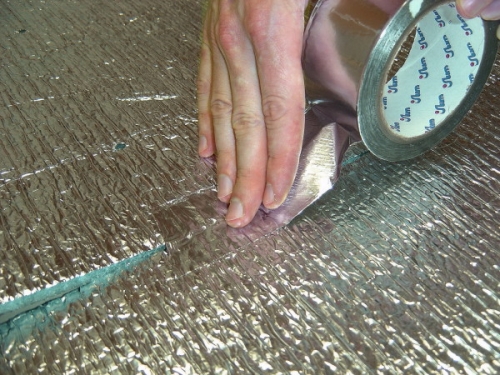
Important! When attaching penofol, one must not forget that aluminum foil is an excellent conductor of electric current. Therefore, with a close location of insulation with electrical wiring, care must be taken to thoroughly insulate the wires
By choosing foil-clad penofol, the characteristics of which correspond to the operating conditions of the material, you can not use additional steam, heat and waterproofing. In addition, it will be possible to save on the purchase of auxiliary and installation tools.
Located directly under the window, then up to 25% of the heat that could heat your house, instead "heats" the street. It can be fixed!
For this we need a material called "penofol". You can buy it at any hardware store and it is quite inexpensive.
We cut out the piece we need to size and glue it to the battery. It can be used on double-sided tape or on small droplets of any universal glue, penofol is very light, so it will not fall off. If you have a sectional radiator, of the type that are found in all our "brezhnevkas", then you can stick it not in one piece, but in smaller pieces.
Penofol reflects up to 97% of the heat that gets on it, so your home will become much more comfortable
It is a safe, non-toxic, excellent thermal insulation material, very easy to install. It is a foamed polyethylene foam. It happens with a single or double-sided layer of foil, with a self-adhesive surface, embossed and much more. For our purposes, one-sided foam foam without a self-adhesive layer is suitable.
Penofol refers to multi-layer reflective insulation materials, consisting of a base and polished foil. Polyethylene foam of various density, thickness and structure is used as a base. Aluminum foil is polished to a reflectance of 97% or more and is heat-welded to one or both sides of the material. The foil is 20 microns thick. The thickness of the base layer can be from 2 to 10 mm. In rare cases, the base can reach 40 mm, but this is only necessary in the most severe climatic conditions.
Reflective insulation was first used in the United States as a spacesuit tool... Then, already in Russia, these technologies were introduced into construction and fully justified themselves.
The action of penofol is similar to that of a regular thermos. If the house is insulated with it, then in the cold season it will be warm, and in the summer it will remain cool. It does not trap the heat emanating from the room, like other types of insulation, but reflects it.
Penofol can be used alone or in conjunction with other heat insulators. It is especially beneficial to use penofol in cases where it is necessary to insulate the walls, floor or ceiling, without reducing the useful area of \u200b\u200bthe room.
Advantages and disadvantages
The advantages of insulation include the following qualities:
Sustainability
- Polyethylene and foil, from which penofol is made, are used to store food, so the toxicity of the material is reduced to almost zero. According to some reports, it even protects against radiation.
- The material is very thin compared to its counterparts, while not inferior to them in quality.A 4 mm thick foam layer with double-sided foil can replace 8-8.5 cm of mineral wool, 3 cm of extruded polystyrene foam or 1.8 cm of wood (pine).
- The use of penofol will not require additional vapor barrier due to the low vapor permeability of the material. It does not matter for him what kind of humidity is indoors or outdoors, and the season does not matter, since the insulation does not absorb moisture.
- Excellent sound insulation.
- Installation of foam foam over the frame of the building structure allows you to protect yourself from both acoustic and structural noise.
- Easy to install, does not break or crumble, does not require special tools and clothing. It is easy to cut with a knife and fasten with small nails, tape or furniture stapler.
Fire safety
- Insulation belongs to the class of hardly flammable and hardly combustible materials.
- Convenient to carry.
- Thanks to a thin layer, the insulation can be easily rolled up into compact rolls and can be transported in the trunk of a car.
- Hard to reach for rodents, which can easily settle in a different (thicker) insulation.
Penofol is certified, has a conclusion from the sanitary and epidemiological authority. Like any of the heaters, penofol has its own drawbacks.
What are they all about?
Softness
- Polyethylene does not have sufficient rigidity, therefore penofol is not suitable for finishing with plaster or. It is enough to put a little pressure on it and the material will bend.
- The insulation is difficult to attach, with the exception of type C foam foam (with a self-adhesive film). For installation, you must use special adhesives. It is impractical to nail it to the surface, since this deteriorates the thermal insulation properties of the material.
- No matter how wonderful penofol is, in buildings it is often used as an additional layer, which will, first of all, reflect thermal energy and protect walls from moisture.
Types
There are several varieties of penofol, each of which is represented by a specific brand. The lettering of the insulation informs about its main characteristics and differences. So, the types of penofol:
- Type A - has an aluminum coating on one side only. It is used, as a rule, in conjunction with other insulation materials, for example, foam or styrodur.
- Type B - coated with aluminum on both sides. Suitable for stand-alone use.
- Type C (self-adhesive) - on one side it has an aluminum layer, and on the other - polyethylene foam with a moisture-resistant contact adhesive applied to it. It is used without the use of additional installation tools.
- Type ALP - a polyethylene film is welded onto the aluminum surface of one of the sides, thanks to which this type of foam is called laminated. Suitable for use in agriculture and mildly aggressive environments.
- Types R and M - embossed foam foil with one-sided foil.
- Super NET, comes from the English "network", respectively, the main purpose of such penofol is the insulation of networks (pipelines, heating mains, air outlets).
- Penofol AIR is used for the manufacture of special air-venting structures.
On sale there is a marking Penofol 2000. It means that the insulation is a cheap version of ordinary penofol, while being inferior to it in strength. The letters denoting the marking may vary with each other. Deciphering is not difficult if the above designations of the types of material are known.
Penofol laying tips:
- the reflective layer of the material is laid in the direction of the heat source;
- for maximum reflection effect, it is necessary to leave an air space of 1.2-2 cm on both sides of the insulation;
- all assembly seams glued with aluminum tape to achieve one hundred percent tightness and waterproofing.
Application
In construction, penofol is used as a middle layer of thermal insulation or as an independent insulation in the following types of work:
- internal and external insulation of walls of buildings, attics, basements, attics;
- water, steam and thermal insulation of baths, saunas, showers;
- insulation of roofs and warm floors;
- insulation of expansion tanks and pipelines;
- heat reflection of home radiators;
- noise insulation and insulation of ventilation, air conditioning and sewerage systems.
Wall insulation technology from the inside
Steam entering building structures from outside leads to the formation of mold and mildew on the inner surface of the walls. This problem is solved by insulating the walls from the inside with penofol, which allows the walls to "breathe" and not accumulate moisture.
Penofol type A, B or C is selected for work. It all depends on the characteristics of the thermal insulation and the planned installation method. Penofol, A is attached to a massive insulation for waterproofing purposes, type B is used independently, type C is mounted on the base of the wall.
The work is carried out in the following order:
- Before the start of installation, a frame is made from wooden slats (1.5-2 cm) on the wall, providing 20 mm of free air space on both sides of the foam. This is necessary for the maximum effect from the use of insulation.
- The bars are fastened with dowels at a distance of no more than 100 cm from each other. An obligatory step before the start of work on laying the penofol will be to check the quality of the wiring and, if necessary, carry out its additional insulation. Aluminum has a high electrical conductivity, due to which the contact of foam foam with bare wires is unacceptable.
- Penofol is attached to the frame with a furniture stapler. The strips are cut with a knife and applied end-to-end, the seams are glued with aluminum tape. It is not recommended to make an overlap fixing, as this will cause condensation to drain down the overlap line in the event of steam generation.
- Then it is reassembled wooden frame (do not forget about the 2 cm air "corridor"). It can be covered with any sheets, slabs or panels that are putty, painted or pasted over with wallpaper.
How to insulate the outside wall with penofol
External insulation of the walls of a house, especially a wooden one, according to experts, is more effective than internal thermal insulation. For this type of insulation, perforated foam foam is used, which, in addition to sound and thermal insulation, protects the building from wind and precipitation and promotes the escape of steam from the structure.
External insulation is suitable in a situation where you do not want to change the interior environment or reduce the useful area of \u200b\u200b\\ u200b \\ u200bthe housing due to thick layers of heat insulator
At the same time, the insulation is mounted between the wall of the house and the cladding. It is very important to carry out external insulation of the house in the warm season, when the temperature drops are minimal, and the walls of the building are completely dry.
Stages of work:
- The work begins by removing all coatings from the walls, which are then treated with an antiseptic. Better to process in dry warm weather... Particular attention is paid to the lower part of the wall and the corners, which are more prone to rotting and freezing. It will take one to two days to dry.
- Then, as with internal insulation, we make a frame from bars. We attach it to self-tapping screws.
- We lay penofol, leaving an air "corridor" and carefully gluing the joints with aluminum tape.
- We mount the outer frame and move on to the cladding of the building. It can be carried out using a metal profile, vinyl siding, corrugated board.
So, having studied the characteristics of one of the most modern heat insulators, we conclude that insulation building structures using penofol is a great way to protect your home from cold, moisture and extraneous noise at the same time. At the same time, the consumption of thermal insulation materials and the loss of the interior space of the house are minimized, which will delight any owner.
Jan 16, 2016 Alex
Penofol is the first brand of insulation with a reflective effect that appeared in Russia. It is a layer of polyethylene foam covered on one or both sides with pure aluminum. The material was developed in 1998 at the "LIT" plant in the Yaroslavl region, at the same time its production began. Over time, many analogues appeared on the market (including those with a metallized coating), but specifications foil-clad Penofol still outperform competitors.
The principle of operation of Penofol is based on the high heat reflectivity of aluminum. Heat losses through the building envelope go in three directions:
- from 15% to 20% - through convection;
- from 3% to 7% - through heat transfer;
- from 65% to 85% - through infrared radiation.
Polished aluminum foil reflects up to 97% of IR radiation, and the bubble polyethylene base provides a vapor and heat insulation effect. The laminate fights heat loss in all three ways.
Important! Heaters with aluminum spraying do not have the same high efficiency. A thin inhomogeneous layer does not contain a sufficient number of UC waves, and the base absorbs thermal radiation.
Applications
The technical characteristics of foil-clad Penofol allow it to be used for thermal insulation of various building structures. These include:
- roof of any type;
- ceiling slabs;
- attic and mansard areas;
- basements and basements;
- underfloor heating systems (water and electric);
- "Warm" and "cold" loggias;
- facades (siding, curtain facades);
- reflectors for heating radiators;
- pipelines and air ducts.
Penofol is also successfully used for domestic purposes - for noise and heat insulation of car bodies.
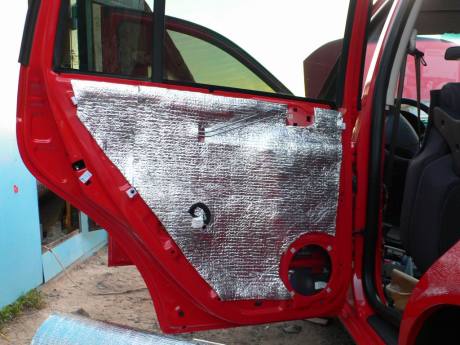
Penofol is often used to insulate cars.
Important! Soft insulation is not suitable for subsequent plastering or wallpapering. In these cases, it is necessary to choose rigid foam boards or extruded polystyrene foam.
Types of Penofol
All varieties of foil-clad Penofol have similar technical characteristics and advantages:
- Small thickness. The maximum layer is 10 mm.
- Multitasking. Suitable for installation in technically challenging locations.
- Protection against harmful radiation. The material is recommended for use in technologically unfavorable areas.
- Resistant to deformation. Penofol instantly restores its shape, is not afraid of strong long-term compression.
- Simple installation. A construction knife and aluminum tape are enough for laying.
- Affordable price. The cost square meter material is several times lower than mineral wool analogs. In retail stores, foil insulation is sold not only in rolls, but also in meters.
Penofol is sold in rolls of various lengths (up to 30 m), the width of the web is 0.6 or 1.2 meters. The thickness of the insulation depends on its type. The standard sizes are 2, 3, 4, 5, 8 and 10 mm.
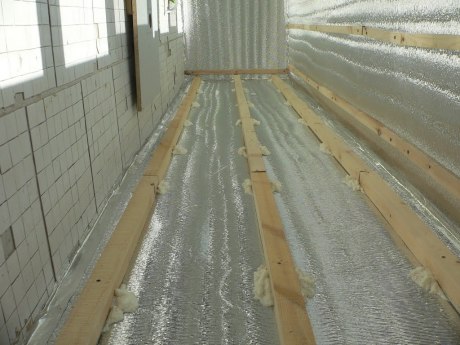
Penofol A
Classic foil insulation. The base is fully closed cell polyethylene foam. On one side, the material is backed up with aluminum foil. Type A is recommended for thermal insulation of internal building structures - walls, ceilings, floors. Penofol A is also suitable for insulating various pipelines, technical containers, industrial equipment, car interiors.
Penofol B
Unlike Penofol A, type B is duplicated with polished aluminum on both sides. The material is used in areas where it is necessary to provide additional warmth in winter and protection from the heat in summer. Insulation with the letter B is recommended for insulation of enclosing structures, attics, loggias, interior surfaces of premises. It is used for construction from scratch and for repairs, insulation of pipelines and equipment.
Penofol C
The same foamed polyethylene is taken as a basis. One side is covered with polished aluminum foil, the other - with an adhesive layer protected by a foil. Type C is designed for use in structures with complex shapes: pipelines, air ducts, drying cabinets, car interiors. It can also be used for any building purpose.
The types of insulation with the letter C are Penofol with protection against counterfeiting (the company logo is applied to the foil) and Penofol classic with polyethylene white and a smoother adhesive layer. The technical characteristics of foil-clad Penofol type C are identical.
Penofol SUPER NET acts as a separate modification of each type (A, B, C). Reinforced material made on the basis of reinforced polyethylene is suitable for insulating critical structures and structures.
Penofol A-LP has been specially developed for use in Warm Floor systems. It is backed up with aluminum foil covered with plastic wrap. The material with additional protection can be used in agricultural premises and laboratories, it is resistant to high levels of alkali and acid vapors.

Physical and mechanical indicators of Penofol
Material specifications
Foil-clad Penofol has the following technical characteristics:
- The temperature of use varies from -60 to +100 degrees.
- The thermal reflection coefficient is not less than 97%, the optical coefficient is not less than 90%.
- The minimum value of the thermal conductivity coefficient is 0.048 W / m C, the maximum is 0.050.
- The vapor permeability coefficient does not exceed 0.001 m 2 ° C / W.
- Impact noise reduction index reaches 20 dB.
- The moisture content during operation varies between 2-5% (depending on the ambient conditions).
- Flammability group - G1.
The efficiency of the insulation with aluminum spraying is most clearly seen in comparison with other building materials... A layer of double-sided four mm Penofol with two air spaces 10 mm thick can replace:
- 41 mm expanded polystyrene (foam);
- 51 mm mineral wool;
- 98 mm wood paneling (conifers);
- 107 mm fine-grained expanded clay;
- 605 mm ceramic bricks;
- 756 mm sand-lime brick.
Data are given for temperature conditions from -20 to +20 degrees.
Important! In the new modification of Penofol with marking 2000, the so-called "uncrosslinked" foams are used, obtained by foaming the raw material with a propane-butane mixture. They are cheaper, but they are inferior in their physical and mechanical characteristics.
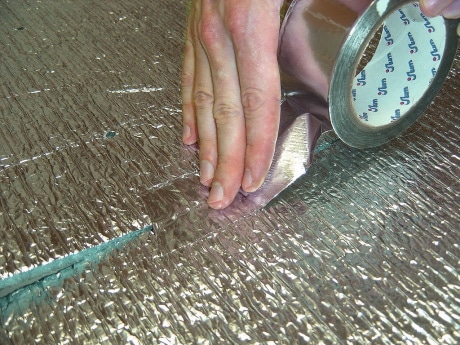
Penofol is laid end-to-end and glued with aluminum tape
Installation features
In order for the technical characteristics of Penofol to correspond to the declared ones, it is necessary to install it correctly. The effective operation of the insulating cake is ensured by the air gaps included in its composition. To achieve the required values \u200b\u200bof thermal resistance in external insulation, 5-6 ventilated layers are required, which is technically difficult to implement. Inside the room, 1-2 gaps are enough, therefore, foil insulation is extremely rarely used for facade work.
Installation procedure:
- Before starting work, inspect the wiring, if necessary, carry out additional insulation. The surface of Penofol should not come into contact with bare or damaged wires - this can lead to a fire.
- Make a frame from wooden slats 15-20 mm thick, fixing them with dowels at a distance of 50-100 cm from each other.
- Cut Penofol to size and secure it to the bars using a furniture stapler. Lay the canvases end-to-end and fix the abutment points with aluminum tape.
- Mount the second part of the frame on top of the insulation and install the sheathing.
Important! Penofol should not be overlapped. When vaporized, condensation will run off at the joints, which can lead to mold or mildew.
Video: comparison of Penofol with its analogues
The technical characteristics of foil-clad Penofol allow it to be used in various household and construction areas... But recently, many fakes have appeared in which not foil is used, but metallized spraying. Such heaters are not so effective in terms of thermal insulation, if not they can even harm your health. Be careful when buying and ask for certificates from sellers!
In the modern construction industry, new innovative materials are constantly being introduced, which are obtained by improving the previously used analogues. Thermal insulation of the dwelling was carried out with traditional materials, which were replaced by a new complex insulator - foil-clad penofol, which combines several different parameters. This successfully allows it to be used as a vapor barrier, thermal insulation, sound insulation of rooms and individual complex structures.
What is Penofol

The thickness of the new effective insulation is millimeters, but according to its technical characteristics, it replaces significant layers of standard insulation materials. The cost of such a heat insulator is several times cheaper than any of the traditional types.
Polyethylene foam is used as a basis in the manufacture of the material. Different categories of penofol contain composed of foamed polyethylene a certain density, structure and thickness.
Foil as additional insulation layer and the coating is applied by hot welding and spraying. High reflectivity is achieved by subsequent grinding, which brings the specified parameter to almost 100%.
Penofol specifications
- The range of temperatures for the use of the material is from 60 ° C frost to critical indicators of liquid boiling at 100 ° C.
- Reflects up to 96% of all incoming heat rays.
- Contains a minimum amount of moisture in the composition, up to 9%, which makes it incapable of destruction during sudden changes in temperature.
- It is produced in a thickness of 3,5,8,10 mm. The thickness of the foil after grinding is about 20 microns.
- Penofol of medium thickness in thermal insulation replaces a layer of two and a half ceramic bricks, three silicate bricks, half a meter of lightweight concrete and up to 40 cm of gas concrete. Mineral insulation should be applied in a layer of 6–8 cm to achieve the same effect.
Positive qualities of the material

There are also some disadvantages:
- Due to its softness, it is not used for finishing walls with putty directly on the layer of material.
- When using types A and B (without self-adhesive film), it is necessary to purchase additionally adhesives for wall and ceiling mounting.
Penofol division into types
Type A provides the presence of foil on one side, used for walls, ceilings, coatings, pipes.
Type B has foil coated on both sides. Applications range from walls to floors and attics.
Type C assumes replacing one of the two layers of foil with a self-adhesive coating. This type of material is more economical and is used in hard-to-reach places.
Areas of use of foil penofol
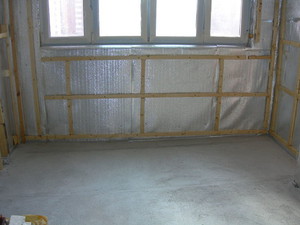
The material is successfully used for insulation from steam and heat loss in the construction of baths, saunas, laundries, swimming pools and similar premises with high humidity.
In production roofing works, insulation of the roof surface from heat loss and steam penetration from the interior.
For leakage protection heat when laying heating pipes, installing heating tanks, containers, ventilation systems and air conditioners. They are installed as a reflector behind heating batteries and, in the need for fire protection, between back wall fireplace and enclosing structure.
When building large refrigeration rooms, refrigerator insulation, delivery vans, refrigerated cars.
Insulation of residential premises, houses, cellars, loggias, balconies.
How to insulate a concrete floor
To begin with, a screed is made of lightweight concrete or a layer of foam plastic is laid with a thickness of about 5 cm. Penofol is attached from above this primary layer with glue or self-adhesive type is chosen. The insulation is mounted with a foil layer inside the room with an approach to the walls, it is connected to each other end-to-end using a foil tape.
If the top foam layer comes into contact with the coating, the moisture that forms on the foil will make it wet. To avoid this, it is necessary to withstand a ventilated lumen that removes moisture. Rails are stuffed or logs are used according to the project, on which floor boards or OSB sheets are attached.
To check the levelness of the floor frame, use a building level. After finishing laying the flooring, finish with linoleum or laminate.
Stages of wall decoration with penofol

Penofol, in addition to heat-insulating qualities, helps save room space, since its layer is much thinner in thickness than similar insulation materials.
All three types of insulation are used to insulate walls and internal partitions. To prevent the accumulation of moisture on the foam foil, create a space with air ventilation with a thickness of 2 cm or more.
Penofol is mounted on the wall surface if an adhesive layer is provided on it. Material with foil on both sides is attached with a ventilated gap device on both sides of the layer.
To do this, a frame is fixed from a rail, an insulator is placed on it, nailing it to the tree with nails, staple brackets or drilling with screws. To create a second air gap, another rack frame is made, and drywall, plywood or chipboard sheets are already mounted on it.
The strips of insulation are joined end-to-end; the best option is to cut the seams for a tighter fit. Seams are protected from unrolling and drafts with aluminum tape.
External wall insulation performed by penofol, if further finishing of the facade is provided with hinged ventilated systems made of plastic, siding and other finishes.
The use of penofol in roof insulation

- Insulation is considered correct when the insulator does not come into contact with moisture from above from precipitation and from below with condensate from human activity. If moisture is formed, a space is made between the layers of the roofing layer for the free passage of ventilation air.
- Condensation is inevitable, because the moisture level in the room rises from the action of various household vapors. In this regard, two ventilation spaces are provided in the overlap. One of them is performed between the roofing material and the waterproofer, and the second one below - between it and the massive insulation.
- Penofol sheets can replace a steam insulator and protect the insulation from moisture if installed with the required gap above and below the insulation.
- The main insulation is attached to the inside of the rafters. And from the outside, sheets of OSB are stuffed, tightly, without gaps. Penofol is glued directly to them, which in this case will act as an insulator from moisture.
- To create a ventilation gap between it and the slate, a full-fledged rack frame made of bars is attached to fasten the roofing material. All bars and slats are treated with antiseptic impregnations before fastening.
- As for fixing penofol inside the attic, after installing the main insulation, a frame is mounted on which the steam insulator is attached with foil inside the room. The rack frame is made again, and then the main ceiling trim is mounted.
Special attention should be paid to the properties of the material, which are defined, as the properties of a "thermos"... This protects all structures and gasket materials from vapors, moisture and heat radiation.
At cost, insulation with penofol will cost three or four times cheaper than using any other insulation.
Penofol is a trademark of foamed polyethylene foam. As the name implies, this is a combined material consisting of two layers: polyethylene foam and aluminum foil. How does foil-clad penofol and its technical characteristics differ from other types of heat-insulating materials? As we know from the school physics course, heat is transferred from object to object in three ways: by convection, i.e. moving heated air; conduction, i.e. the thermal conductivity of the objects themselves; thermal radiation, i.e. transfer of heat from one object to another using electromagnetic waves in the infrared spectrum. Most thermal insulation materials inhibit one type of heat transfer. Penofol, on the other hand, has a combined effect: foamed polyethylene prevents convection, and thanks to aluminum foil, the thermal reflection coefficient of penofol reaches 97%. The overall coefficient of resistance to heat transfer of foam foam at a thickness of 10 mm reaches 1.355 (for comparison, the coefficient of resistance to heat transfer at brick wall 54 cm thick - 0.405). Thus, using foil-clad penofol, you can achieve a good heat-insulating effect with a small thickness of insulation.
In addition to thermal insulation properties, penofol also has a number of other useful qualities: it is vapor-proof, lightweight and easy to install, resistant to mechanical abrasion, environmentally friendly, according to some reports, even protects against radiation. Therefore, foil-clad penofol and its characteristics are widespread in industrial and civil construction, they are used for insulation at any facility, from a bathhouse to a main pipeline.
Penofol types. Installation of penofol.

Traditionally, there are three modifications of foil-clad penofol:
- "A" - with one-sided foil, is mainly used for insulation of walls, roofs from the inside, as well as insulation of engineering systems;
- "B" - with double-sided foil, used for insulation floor slabs and internal partitions;
- "C" - with one-sided foil and self-adhesive layer, used in cases where the use of other brands is technically difficult.
However, at present there are many modifications of this material, in particular, with the use of other types of foil and foam components, internal reinforcement, perforation, etc. Penofol is produced in rolls and has a thickness of 3, 4, 5, 8, and 10 mm.
Installation of penofol is relatively simple, subject to certain rules. The basic rule is that there should be a ventilation distance of 1.5-2 cm between penofol and other structural elements. This is due to the fact that penofol is absolutely waterproof. Moisture can accumulate on its surface (especially if it is at the "dew point"), due to which other structural elements will constantly get wet. Penofol is fastened with a construction stapler or glue, with the foil side inside the room. Most the best way installation - "in the joint", however, sometimes, for example, when insulating the attic, it is allowed to overlap the upper layer over the lower width up to 10 cm. Joints must be glued with aluminum tape-tape. It should also be remembered that aluminum is a good conductor of electricity, so all wiring near the foam must be well insulated. It is advisable to use penofol in combination with other insulation materials (expanded polystyrene, mineral wool, etc.) to achieve the best effect.



